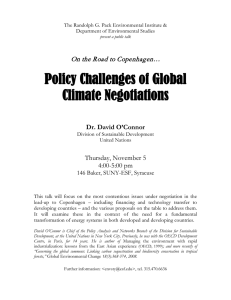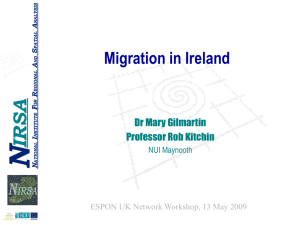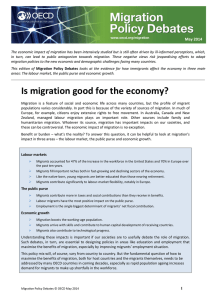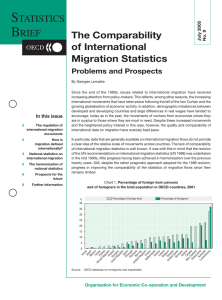Domestic training and international recruitment of health workers Jean-Christophe Dumont
advertisement
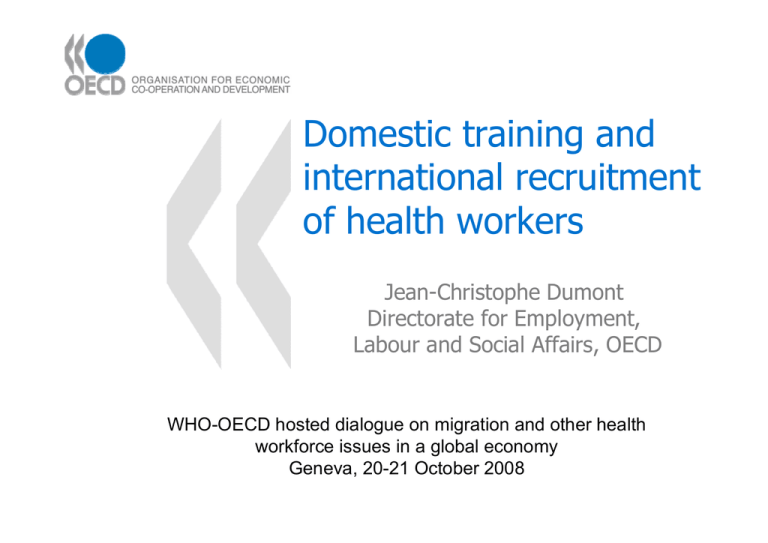
Domestic training and international recruitment of health workers Jean-Christophe Dumont Directorate for Employment, Labour and Social Affairs, OECD WHO-OECD hosted dialogue on migration and other health workforce issues in a global economy Geneva, 20-21 October 2008 Background Immigration trends (1/3) ● Migrant health workers represent a significant share of the health workforce in many OECD countries … ● … but emigration to other OECD countries can also be important ● Few LDCs have a lot of foreign health workers Immigration and expatriation rates of health professionals (except nurses) in selected OECD, circa 2000 Source: OECD (2008) The looming crisis in the health workforce. How can OECD countries respond? Immigration trends (2/3) Inflow of doctors and nurses in selected OECD countries, 1995-2005 ● Over the past 5-10 years migration of both doctors and nurses has increased significantly... ● … despite the absence of specific migration policies… ● … but in the context of increasing focus on selective highly skilled migration. Immigration trends (3/3) ● The main drivers of recent migration trends are twofold: — General context of migration, including emigration — Unforeseen mismatch between supply and demand (cobweb model) ● Source countries / determinants of emigration — Philippines and India / Caribbean and Sub-Saharan countries — Push factors and pull factors Expatriation rates of highly skilled and doctors, non OECD countries circa 2000 Education trends (1/2) ● Most OECD countries exercise some form of control over student intakes ● Intake to medical and nursing schools has followed a U-shaped curve in many OECD countries MedicaI school enrolment in selected OECD countries, 1990 = 100 200 180 160 140 120 100 80 19 90 19 91 19 92 19 93 19 94 19 95 19 96 19 97 19 98 19 99 20 00 20 01 20 02 20 03 20 04 20 05 60 France England United States Canada New -Zealand Sources: Cash R. and Ulman P. (2007), Bosanquet N., A. Haldenby, H. DE Zoete et al. (2006), Cooper R., (2006), New Zealand Medical Council (2006) and Association of Faculties of Canada. Education trends (2/2) ● Training of health professionals remains a challenge for many less developed countries : — Not all countries have a medical school — Lack of financial and human resources ● Training health professionals for the world market — Better sharing of training costs — Do large countries offer the “cornu copiae” ? ● Adjust curricula to train quicker and better match the needs of the local population as well as to reduce transferability of diplomas Selected challenges and possible policy responses (1/2) Selected challenges and possible policy responses (2/2) Selected issues and perspective • Lessons to be learned across countries about coordination between migration, education and health Departments • International migration and domestic training: the notion of self-sufficiency • Future international information sharing and cooperation in relation to anticipated global health workforce shortages Selected issues and perspective • Can lessons be learned across countries about coordination between migration, education and health Departments ? • International migration and domestic training: is the notion of self-suficiency a realistic one ? • What sort of future international information sharing and co-operation, if any, would be appropriate in relation to anticipated future, global health workforce shortages ?






